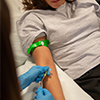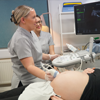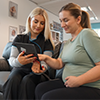Symphysis Pubis Dysfunction (SPD) or pregnancy-related pelvic girdle pain (PPGP) is very common. In fact, it affects up to one in five pregnant women. If causes many women a constant niggling pain, but it can also be so severe that it leaves some stranded-on crutches until birth. Fortunately, there is lots of help available and plenty that you can do to ease the pain.
SPD can also feel like a shooting pain in the legs or a teeth-on-edge grinding feeling in your undercarriage. Just what you need when you have four boxes of flatpack nursery furniture to put together.
Some of Your Questions & Answers Below:
What is SPD? SPD is a problem with your pelvis. The ‘symphysis’ is where your pelvic bones, held together by ligaments, join at the front of your pelvis. There are other ‘fixed’ joints at each side of the bottom of the spine (sacroiliac), forming he heart-shaped pelvic bones. You’ll also hear some medical professionals refer to it as ‘pregnancy-related pelvic girdle pain’ (PPGP), though strictly speaking, SPD is just one type of pelvic girdle pain. It’s a condition crying out for a snappy name, that’s for sure.
What Causes SPD?
During pregnancy, a hormone called ‘Relaxin’ loosens the pelvic ligaments to allow the pelvis to open slightly when you give birth. Obviously, this is a positive thing, but it can mean the ligaments in your pelvis loosen too much and too early, so your normally stable pelvis is suddenly more flexible that is ideal. Your joins also get stiff and swollen during pregnancy. If you add to that the increasing weight of your growing baby and it is very easy for the area to become unstable, meaning the symphysis joint can separate, leaving you with the mild to severe pain. It’s very common but you are more likely to suffer if you:
1- Had SPD in a previous pregnancy
2- Have an existing pelvic injury (such as from an accident)
3- Were overweight before pregnancy
4- Suffer from hypermobility
5- Have a very physical job
What Does SPD Feel Like?
You can feel the pain in your pubic area, groin, the insides of your thighs and hips and one or both buttocks. Some women describe a clicking feeling or sound, others say it feels like their pelvic bones are grinding together. It can often feel like a sharp pain too, and will get worse when you’re doing anything that means your leg being wider apart. The pain makes walking, turning in bed, climbing stairs, getting dressed and getting in and out of a car feel pretty dire – so pretty much all the things you need to get done on a daily basis.
When Does SPD Start?
It can start at any time but it usually is in the second trimester. The bad news is that it doesn’t tend to get better until after your baby is born.
Will Having SPD Affect My Labour and Birth?
If managed well, no, it shouldn’t cause any problems and here isn’t any need to have a caesarean section. However, there is no denying that labour can be a daunting prospect if, during pregnancy, you’re so immobilised you’re on crutches or in a wheelchair. Add that you have SPD to your birth plan so that all doctors and midwives are aware.
Tips to Ease the Pain:
Speak to a physio about any exercises and positions that can help.
Make sure you avoid any heavy lifting or pushing but try stay as active as you can to avoid the area seizing up completely
Keep your legs together as much as possible, especially when getting out of bed, and try to not stand on one leg (for example when you put on your socks!)
What can also help:
Take the stairs one at a time and don’t over reach or stretch
A warm wheat pack can bring relief (Make sure keeping the heat pack away from your baby bump). Warm Baths are a must! Also Swimming can be relaxing and a good form of exercise.
Try doing some jobs that you normally do standing up (like ironing) sitting down
Use a pregnancy support pillow between your knees at night to keep your pelvis in line.
Treatment:
The pain won’t be completely resolved until after the baby is born and your hormone levels go back to normal but there is lots of help available to enable you to manage it. Mention it to your GP or your midwife at your next appointment to refer you on.
It is important to get advice from a physiotherapist because it doesn’t necessarily get better as soon as you’ve given birth, so you may continue to need treatment for a while after.
Treatments may include:
1- Physiotherapy to restore movement to the area
2- Advice on exercises you can (and shouldn’t) do to strengthen your pelvic floor and other muscles around the area
3- Giving you a pelvic support belt or crutches if needed
4- Lifestyle changes our physio can advise you on
5- Osteopathy or acupuncture
Positions for Labour:
Standing position or kneeling upright with support are best if you can manage it. Try to avoid squatting. Unless it is necessary to help baby, midwives will not put your legs in stirrups without first measuring how far you can open your legs painlessly, or hold onto your legs and push back during the second stage. If it helps with the pain of labour, wiggle your hips, and continue your physio exercises as a warm up. A water birth is an option for you to consider as it will give you a feeling of weightlessness.
SPD After Pregnancy:
For most women, SPD slowly eases off in the days and weeks after birth but don’t expect it to vanish overnight. In some cases, it can linger a while longer and may need further physiotherapy in the early days post-birth to help see it on its way. In a very small number of cases, it doesn’t get better and further treatment is needed, but this is very rare.
Interestingly, you might find that once things return to normal, you still get twinges at the time of the month your period is due. This is probably because of hormonal changes softening ligaments again slightly. Take it easy if this is the case but it’s not something to worry about.













 Packages & Prices
Packages & Prices  Important Info & Policies
Important Info & Policies  Your Scan
Your Scan